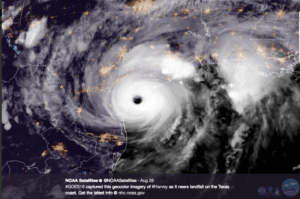The big story within the weather community in the last few days has been GOES-16 and the unbelievable minute-by-minute imagery it provided of Hurricane Harvey developing in real time.
This is happening with all aspects of weather data, and not just the bird’s eye view from space. There are now more observations than ever from underneath and within storms. Data from wireless networks, radar, observation networks or mesonets, and crowd-sourced observations (people calling in storm reports or submitting them through apps in real time) can provide ground-truth and ground-level detail about rain intensity and location.
- Texas evacuation zones map.
- NOAA Image — GOES-16 Satellite captures this geocolor image of Hurricane Harvey making landfall on the Texas coast.
“The WSR-88D Doppler radar is operated in one of two modes — clear air mode or precipitation mode. In clear air mode, images you see are updated every 10 minutes. In precipitation mode…every five or six minutes.” –Weather.gov
Hurricane Harvey is likely to go down in history as one of the worst natural disasters to ever hit the US. The storm itself was forecast accurately days in advance, but a good forecast isn’t enough to mitigate danger — many people were not able to evacuate, frustrating meteorologists and complicating emergency management and relief efforts. Even today after the rains have stopped in Houston, the rescue effort continues as flooding spreads, making real-time assessment of ongoing weather hazards all the more critical.
Part of disaster preparedness happens long before severe weather strikes — this means investments in infrastructure, risk assessments, matrices, and incident response plans. But what happens in real-time? Responders need to be agile in rapidly shifting, hazardous conditions, and that means using big data to get the most updated observations and the most accurate short-term forecasts.
The future of meteorology is all about leveraging real-time data to help guard against volatile, real-time impacts.
The future of meteorology is all about leveraging real-time data to help guard against volatile, real-time impacts. This will change how emergency managers take action and deploy resources from first responders and equipment in order to protect property and save lives.
Daniel Rothenberg, Tomorrow.io’s Director of Meteorology, contributed to this post.
Tomorrow.io, Inc. is a Boston-based weather tech company that provides high-definition weather forecasting tools to businesses and governments worldwide. Tomorrow.io is the first to offer instant access to reliable street-level weather data in real-time.
















